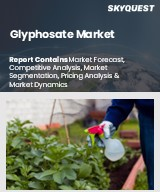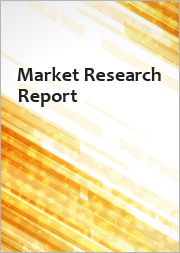
|
시장보고서
상품코드
1577310
글리포세이트 시장, 기회, 성장 촉진요인, 산업 동향 분석과 예측(2024-2032년)Glyphosate Market, Opportunity, Growth Drivers, Industry Trend Analysis and Forecast, 2024-2032 |
||||||
세계의 글리포세이트 시장은 2023년에 약 62억 1,000만 달러로 평가되며, 2024-2032년 CAGR 4.5% 이상으로 성장할 것으로 예측됩니다.
세계의 농업 활동이 급증하는 인구의 식량 수요를 충족시키기 위해 확대됨에 따라 효과적인 잡초 방제 솔루션에 대한 수요가 급증하고 있습니다. 글리포세이트는 광범위한 효능으로 인해 가장 선호되는 선택이 되고 있습니다. 유전자변형(GM) 작물의 등장으로 글리포세이트의 사용량이 증가하고 있습니다. 농가는 글리포세이트의 비용 효율성과 작물 수확량과 생산성을 향상시키는 능력 때문에 글리포세이트 사용을 선호합니다. 또한 글리포세이트는 공공 공원이나 주거용 잔디밭과 같은 비농업 환경에서의 사용이 확대되면서 수요가 증가하고 있습니다.
글리포세이트 산업은 몇 가지 눈에 띄는 추세를 목격하고 있습니다. 정밀농업 기술의 채택이 증가함에 따라 글리포세이트의 사용량이 최적화되어 낭비를 최소화하면서 효과를 높이고 있습니다. 활발한 연구개발로 환경에 미치는 영향을 줄이는 개선된 제형이 개발되고 있습니다. 그러나 규제 당국의 감시가 강화되고 공중 보건에 대한 우려가 커지면서 일부 지역에서는 제초제 사용을 규제하거나 대체 제초제를 고려하고 있습니다. 글리포세이트와 같은 합성 제초제를 기피하는 유기농업 증가 추세는 시장 수요에 대한 잠재적인 도전이 되고 있습니다. 그럼에도 불구하고 글리포세이트는 그 효과와 비용 효율성이 입증되어 여전히 지배적인 제초제로 남아있습니다.
시장은 관행 작물과 유전자 변형 작물 모두에 대해 용도별로 구분되며, 2023년에는 GM 작물이 29억 8,000만 달러로 가장 큰 시장 점유율을 차지하고 2032년에는 47억 2,000만 달러로 급성장할 것으로 예상됩니다. 글리포세이트 분야에서 GM 작물의 우위는 제초제에 대한 유전자 변형 저항성에 기인합니다. 이 독특한 형질로 인해 농가는 글리포세이트의 직접 살포가 가능해져 작물에 해를 끼치지 않고 잡초를 효과적으로 방제할 수 있으며, 수확량을 늘릴 수 있습니다. 글리포세이트 내성 유전자 변형 작물로 잡초 관리를 간소화하면 노동력과 비용을 절감할 수 있습니다. 또한 주요 농업 지역에서 이러한 작물이 널리 채택됨에 따라 글리포세이트에 대한 수요가 증가하고 GM 작물이 주요 용도로 자리 잡으면서 글리포세이트 시장 리더십이 강화될 것입니다.
2023년 아시아태평양의 글리포세이트 시장은 21억 4,000만 달러의 매출을 기록했으며 2032년까지 34억 6,000만 달러로 증가할 것으로 예상됩니다. 아시아태평양의 강점은 방대한 농업 활동과 급속한 인구 증가로 인해 작물 수확량과 효율적인 농법에 대한 수요가 증가하고 있기 때문입니다. 다양한 기후 조건과 광활한 경작지 면적을 가진 아시아태평양은 농업의 중요한 거점으로서 효과적인 잡초 방제 솔루션의 필요성을 강조합니다. 이 지역의 농가는 생산성을 높이고 식량안보를 보장하기 위해 광범위하게 효과적이고 비용 효율적인 것으로 알려진 글리포세이트(glyphosate)를 광범위하게 활용하고 있습니다.
목차
제1장 조사 방법과 조사 범위
제2장 개요
제3장 업계 인사이트
- 에코시스템 분석
- 주요 제조업체
- 유통업체
- 업계 전체의 이익률
- 업계에 대한 영향요인
- 촉진요인
- 시장이 해결해야 할 과제
- 시장 기회
- 새로운 기회
- 성장 가능성 분석
- 원재료 상황
- 제조 동향
- 기술의 진화
- 지속가능 제조
- 그린 프랙티스
- 탈탄소화
- 지속가능 제조
- 원재료의 지속가능성
- 가격 동향(달러/톤), 2021-2032년
- 규제와 시장에 대한 영향
- Porter의 산업 분석
- PESTEL 분석
제4장 경쟁 구도
- 기업 점유율 분석
- 경쟁 포지셔닝 매트릭스
- 전략 전망 매트릭스
제5장 시장 규모·예측 : 용도별, 2021-2032년
- 주요 동향
- 기존형 작물
- 유전자재조합 작물
제6장 시장 규모·예측 : 지역별, 2021-2032년
- 주요 동향
- 북미
- 미국
- 캐나다
- 유럽
- 독일
- 영국
- 프랑스
- 이탈리아
- 스페인
- 러시아
- 기타 유럽
- 아시아태평양
- 중국
- 인도
- 일본
- 호주
- 한국
- 말레이시아
- 인도네시아
- 기타 아시아태평양
- 라틴아메리카
- 브라질
- 멕시코
- 아르헨티나
- 기타 라틴아메리카
- 중동 및 아프리카
- 사우디아라비아
- 남아프리카공화국
- 아랍에미리트
- 기타 중동 및 아프리카
제7장 기업 개요
- Aimco Pesticides Limited
- ALPL Agrochemicals
- Anhui Huaxing Chemical Industry Company Ltd.
- Aristo Biotech and Life Science Pvt. Ltd.
- BASF Corporation
- Bayer Cropscience Ltd.
- Bhaskar Agrochemicals Ltd.
- Crop Life Science Ltd.
- Dow AgroSciences
- DuPont
- FMC Corporation
- Insecticides India Ltd.
- Jiangsu Good Harvest-Weien Agrochemical Co., Ltd.
- Nantong Jiangshan Agrochemical and Chemicals Co., Ltd.
- Nufarm Limited
- PI Industries Ltd.
- Rivera Agrical Industries
- Shandong Weifang Rainbow Chemical
- Sikko Industries Ltd.
- SinoHarvest Corporation
- Syngenta
- Zhejiang Xinan Chemical Industrial Group Co., Ltd.
The Global Glyphosate Market was valued at approximately USD 6.21 billion in 2023 and is projected to grow at a CAGR of over 4.5% from 2024 to 2032. As global agricultural activities expand to satisfy the food needs of a burgeoning population, the demand for effective weed control solutions has surged. Glyphosate stands out as a preferred choice due to its broad-spectrum efficacy. The rise of genetically modified (GM) crops, often engineered to be resistant to glyphosate, has amplified its usage. Farmers favor glyphosate for its cost-effectiveness and ability to boost crop yield and productivity. Moreover, glyphosate's growing application in non-agricultural settings, like public parks and residential lawns, bolsters its demand.
The glyphosate industry is witnessing several prominent trends. The increasing adoption of precision farming techniques is optimizing glyphosate usage, enhancing its effectiveness while minimizing wastage. Active research and development are yielding improved formulations that lessen environmental impact. Yet, heightened regulatory scrutiny and public health concerns are leading some regions to impose restrictions or explore alternative herbicides. The rising trend of organic farming, which shuns synthetic herbicides like glyphosate, poses a potential challenge to market demand. Nevertheless, due to its proven effectiveness and cost-efficiency, glyphosate continues to be a dominant herbicide.
The overall glyphosate industry is classified based on application and region.
Segmented by application, the market caters to both conventional and GM crops. In 2023, GM crops commanded a significant market share, valued at USD 2.98 billion, with projections to soar to USD 4.72 billion by 2032. The dominance of GM crops in the glyphosate arena stems from their engineered resistance to the herbicide. This unique trait empowers farmers to apply glyphosate directly, ensuring effective weed control without harming the crops, thereby boosting yield. The streamlined weed management, courtesy of glyphosate-resistant GM crops, translates to reduced labor and costs. Furthermore, the prevalent adoption of these crops in key agricultural regions amplifies the demand for glyphosate, cementing GM crops as the primary application and reinforcing glyphosate's market leadership.
In 2023, Asia Pacific glyphosate market generated revenues of USD 2.14 billion, with forecasts predicting a rise to USD 3.46 billion by 2032. The region's dominance is attributed to its vast agricultural activities and a swiftly growing population, both of which heighten the demand for robust crop yields and efficient farming methods. With its varied climatic conditions and expansive arable land, Asia Pacific stands as a pivotal agricultural hub, underscoring the necessity for effective weed control solutions. Farmers across the region extensively utilize glyphosate, celebrated for its broad-spectrum efficacy and cost-effectiveness, to bolster productivity and ensure food security.
Table of Contents
Chapter 1 Methodology and Scope
- 1.1 Market scope and definition
- 1.2 Base estimates and calculations
- 1.3 Forecast calculation
- 1.4 Data sources
- 1.4.1 Primary
- 1.4.2 Secondary
- 1.4.2.1 Paid sources
- 1.4.2.2 Public sources
Chapter 2 Executive Summary
- 2.1 Industry 360° synopsis
Chapter 3 Industry Insights
- 3.1 Industry ecosystem analysis
- 3.1.1 Key manufacturers
- 3.1.2 Distributors
- 3.1.3 Profit margins across the industry
- 3.2 Industry impact forces
- 3.2.1 Growth drivers
- 3.2.2 Market challenges
- 3.2.3 Market opportunity
- 3.2.3.1 New opportunities
- 3.2.3.2 Growth potential analysis
- 3.3 Raw material landscape
- 3.3.1 Manufacturing trends
- 3.3.2 Technology evolution
- 3.3.2.1 Sustainable manufacturing
- 3.3.2.1.1 Green practices
- 3.3.2.1.2 Decarbonization
- 3.3.2.1 Sustainable manufacturing
- 3.3.3 Sustainability in raw materials
- 3.3.4 Pricing trends (USD/Ton), 2021 - 2032
- 3.3.4.1 North America
- 3.3.4.2 Europe
- 3.3.4.3 Asia Pacific
- 3.3.4.4 Latin America
- 3.3.4.5 Middle East and Africa
- 3.4 Regulations and market impact
- 3.5 Porter's analysis
- 3.6 PESTEL analysis
Chapter 4 Competitive Landscape, 2023
- 4.1 Company market share analysis
- 4.2 Competitive positioning matrix
- 4.3 Strategic outlook matrix
Chapter 5 Market Size and Forecast, By Application, 2021-2032 (USD Million, Kilo Tons)
- 5.1 Key trends
- 5.2 Conventional crops
- 5.3 GM Crops
Chapter 6 Market Size and Forecast, By Region, 2021-2032 (USD Million, Kilo Tons)
- 6.1 Key trends
- 6.2 North America
- 6.2.1 U.S.
- 6.2.2 Canada
- 6.3 Europe
- 6.3.1 Germany
- 6.3.2 UK
- 6.3.3 France
- 6.3.4 Italy
- 6.3.5 Spain
- 6.3.6 Russia
- 6.3.7 Rest of Europe
- 6.4 Asia Pacific
- 6.4.1 China
- 6.4.2 India
- 6.4.3 Japan
- 6.4.4 Australia
- 6.4.5 South Korea
- 6.4.6 Malaysia
- 6.4.7 Indonesia
- 6.4.8 Rest of Asia Pacific
- 6.5 Latin America
- 6.5.1 Brazil
- 6.5.2 Mexico
- 6.5.3 Argentina
- 6.5.4 Rest of Latin America
- 6.6 MEA
- 6.6.1 Saudi Arabia
- 6.6.2 South Africa
- 6.6.3 UAE
- 6.6.4 Rest of MEA
Chapter 7 Company Profiles
- 7.1 Aimco Pesticides Limited
- 7.2 ALPL Agrochemicals
- 7.3 Anhui Huaxing Chemical Industry Company Ltd.
- 7.4 Aristo Biotech and Life Science Pvt. Ltd.
- 7.5 BASF Corporation
- 7.6 Bayer Cropscience Ltd.
- 7.7 Bhaskar Agrochemicals Ltd.
- 7.8 Crop Life Science Ltd.
- 7.9 Dow AgroSciences
- 7.10 DuPont
- 7.11 FMC Corporation
- 7.12 Insecticides India Ltd.
- 7.13 Jiangsu Good Harvest-Weien Agrochemical Co., Ltd.
- 7.14 Nantong Jiangshan Agrochemical and Chemicals Co., Ltd.
- 7.15 Nufarm Limited
- 7.16 PI Industries Ltd.
- 7.17 Rivera Agrical Industries
- 7.18 Shandong Weifang Rainbow Chemical
- 7.19 Sikko Industries Ltd.
- 7.20 SinoHarvest Corporation
- 7.21 Syngenta
- 7.22 Zhejiang Xinan Chemical Industrial Group Co., Ltd.



















